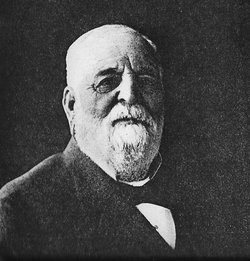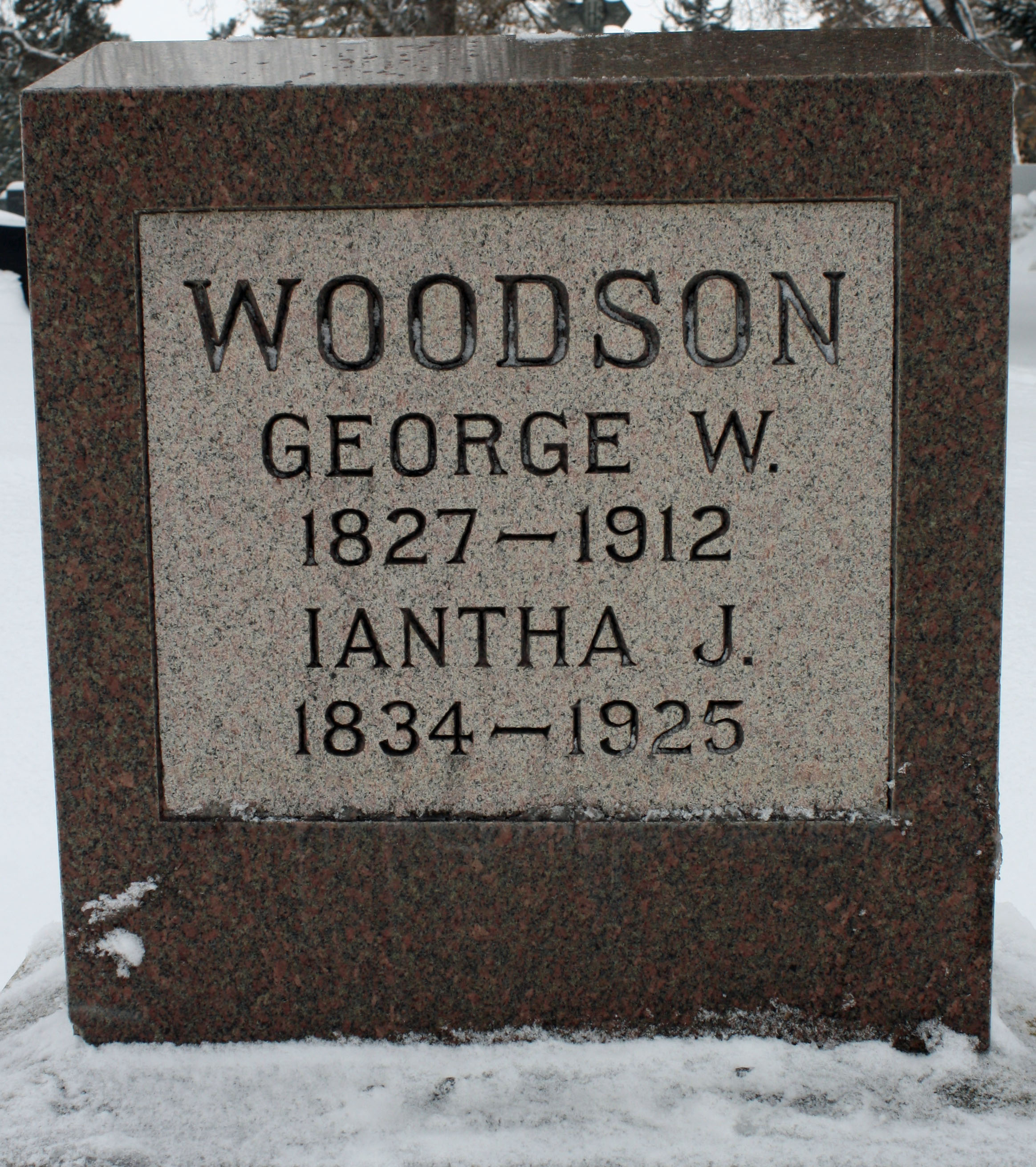On December 3, 1863, twin daughters, Mary and Martha, were born to us, but Mary died at the age of thirteen months.
When the Civil War come on, I early joined Brigadier General Rain's command and fought through the Wilson Creek battle as a private soldier. Soon after this battle I was promoted to the rank of first lieutenant. A few months later, after the battle of Lexington, Missouri and at the resignation of the captain of our company, I was elected to fill his vacancy, and so continued until the Missouri state guards were disbanded for the purpose of joining the Confederate army. Shortly after this, I was captured and held prisoner by the Federal troops for about two months, when I was released by taking the oath and giving bond. This ended my career as a soldier.
On April 1, 1865 I left Monroe county, Missouri with my wife and daughter, Martha, and started, with an ox team for Oregon. We arrived at Fort Carney in the state of Nebraska about the 25th day of May, 1865. As the Indians on the plains were hostile that year, the government would not allow us to proceed until enough wagons gathered to form a company. We had to wait only a couple of days for this; and then a company consisting of one hundred and ten wagons was organized. I was elected captain and given a regular commission by the government. We then started on our journey. We had no trouble with the Indians until we arrived at Rock Springs, in what is now Wyoming, where we were attacked by the Sioux and Cheyennes. We fird on them, driving them away without anyt loss whatever to our company. We arrived at Fort Halleck next day, and after resting two or three days, proceeded on our journey, reaching out destination on September 6, 1865.
The first year after we arrived in Oregon, I farmed, but in the fall of 1866 I became engaged in the mercantile business at Amity, Oregon, under the firm style of Brown, Woodson & Co.
After being in this business for five years, I sold my interest in it and in 1872 bought sheep and took them to Klarnath Lake county. I remained there a couple of years, and during that time went through the Modoc Indian War. I then returned to Amity and again went into the mercantile business, in which I continued as long as I lived in Oregon.
In 1885 I moved my family to Paris, in Monroe county, Missouri, and while living there my daughter was married to Preston B. Moss of that town. In 1893 my wife and I moved to Billings, Montana, the home of my daughter at that time, and have resided there ever since. Before and After I went to Oregon I voted the democratic ticket, but for the past ten years have voted republican. I never have been a member of any church or lodge."
Signed: George Warren Woodson
OBIT:
A little more than a year after writing the above, sketch, he died at 7:30 o'clock Saturday evening, March 30, 1912 at the home of his daughter, Mrs. Preston B. Moss in Billings, Montana. A local newspaper commenting upon his death, adds:
"While Capt. Woodson was not a man of demonstrative character, he came from the old school of Virginians who knew but one code of morals in life and strict morality and rectitude in all his dealings with his fellow men was ever his rule. During the time he was a citizen of Montana he was not engaged in business, being identified with the community only as a resident. He is survived by his wife and daughter, and a number of grandchildren. Funeral services were conducted from the Moss residence, the Christian Science burial service being used, and interment was made in the local cemetery."
On December 3, 1863, twin daughters, Mary and Martha, were born to us, but Mary died at the age of thirteen months.
When the Civil War come on, I early joined Brigadier General Rain's command and fought through the Wilson Creek battle as a private soldier. Soon after this battle I was promoted to the rank of first lieutenant. A few months later, after the battle of Lexington, Missouri and at the resignation of the captain of our company, I was elected to fill his vacancy, and so continued until the Missouri state guards were disbanded for the purpose of joining the Confederate army. Shortly after this, I was captured and held prisoner by the Federal troops for about two months, when I was released by taking the oath and giving bond. This ended my career as a soldier.
On April 1, 1865 I left Monroe county, Missouri with my wife and daughter, Martha, and started, with an ox team for Oregon. We arrived at Fort Carney in the state of Nebraska about the 25th day of May, 1865. As the Indians on the plains were hostile that year, the government would not allow us to proceed until enough wagons gathered to form a company. We had to wait only a couple of days for this; and then a company consisting of one hundred and ten wagons was organized. I was elected captain and given a regular commission by the government. We then started on our journey. We had no trouble with the Indians until we arrived at Rock Springs, in what is now Wyoming, where we were attacked by the Sioux and Cheyennes. We fird on them, driving them away without anyt loss whatever to our company. We arrived at Fort Halleck next day, and after resting two or three days, proceeded on our journey, reaching out destination on September 6, 1865.
The first year after we arrived in Oregon, I farmed, but in the fall of 1866 I became engaged in the mercantile business at Amity, Oregon, under the firm style of Brown, Woodson & Co.
After being in this business for five years, I sold my interest in it and in 1872 bought sheep and took them to Klarnath Lake county. I remained there a couple of years, and during that time went through the Modoc Indian War. I then returned to Amity and again went into the mercantile business, in which I continued as long as I lived in Oregon.
In 1885 I moved my family to Paris, in Monroe county, Missouri, and while living there my daughter was married to Preston B. Moss of that town. In 1893 my wife and I moved to Billings, Montana, the home of my daughter at that time, and have resided there ever since. Before and After I went to Oregon I voted the democratic ticket, but for the past ten years have voted republican. I never have been a member of any church or lodge."
Signed: George Warren Woodson
OBIT:
A little more than a year after writing the above, sketch, he died at 7:30 o'clock Saturday evening, March 30, 1912 at the home of his daughter, Mrs. Preston B. Moss in Billings, Montana. A local newspaper commenting upon his death, adds:
"While Capt. Woodson was not a man of demonstrative character, he came from the old school of Virginians who knew but one code of morals in life and strict morality and rectitude in all his dealings with his fellow men was ever his rule. During the time he was a citizen of Montana he was not engaged in business, being identified with the community only as a resident. He is survived by his wife and daughter, and a number of grandchildren. Funeral services were conducted from the Moss residence, the Christian Science burial service being used, and interment was made in the local cemetery."
Family Members
-
![]()
Ann Eliza Woodson Loat
1806–1881
-
![]()
Paulina Bacon Woodson Miller
1809–1879
-
![]()
Mary Royall Woodson Craig
1811–1890
-
![]()
Stephen Martel Woodson
1814–1901
-
![]()
Martha LeSueur Woodson Craig
1816–1867
-
![]()
Caroline Chastain Woodson Maddox
1819–1913
-
![]()
Dorothy Randolph "Dollie" Woodson
1822–1904
-
![]()
Elizabeth Mosby Woodson Allison
1824–1924
-
![]()
Maria Jane Woodson Boyd
1830–1862
Sponsored by Ancestry
Advertisement
Advertisement

























